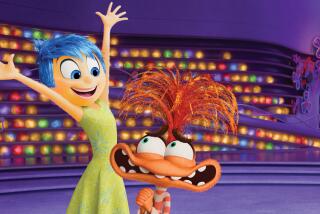The Financial Magic of ‘Cinderella’ : Cartoon Rescued Postwar Disney Studios From Ruin
- Share via
Like “Snow White and the Seven Dwarfs,” which it resembles in many ways, “Cinderella” (1950, in re-release citywide) saved Walt Disney’s studio from imminent foreclosure. If it had failed, there would have been no “Peter Pan,” no “Mickey Mouse Club” and no Disneyland.
The postwar years were a difficult time for Walt Disney. “Pinocchio,” “Fantasia” and “Bambi” had yet to show a profit. None of the ‘40s “package features” had been been particularly successful. Disney seemed to have lost the mass audience that had flocked to “Snow White” and his short cartoons, and the intellectuals, who had taken up his work during the ‘30s. He owed the Bank of America millions of dollars, and the situation was growing desperate.
Disney decided to risk everything on a single feature-length cartoon. Like “Snow White,” “Cinderella” was a well-loved fairy tale that centered on a pretty, sympathetic heroine. But this film had to be made on schedule and on a tight budget. He couldn’t afford to scrap months of work, as he had done on “Snow White” and “Pinocchio.”
For the first time, the Disney artists shot the entire film in live action before they began animating. (They had shot reference footage of difficult sequences before, but not a complete film.) The artists didn’t trace this footage, but the gestures, expressions and movements of the actors provided a starting point with their drawings.
“You can approach a sequence two ways: You can do it the hard way, which is to start from scratch, animate it out of your head and end up with a first rough,” explains Marc Davis, who did much of the animation of the title character in “Cinderella.” “Or you can use the live action to give you that first rough. It also helps to keep the character consistent throughout the film, as one person generally doesn’t animate all of a character’s scenes.”
The artists felt that the audience had to believe that Cinderella and her Stepmother were real people, or the story would simply fall apart. The live-action footage enabled the animators to create convincingly realistic movements for the two characters, which contrast with the more cartoonish antics of the ugly Stepsisters and the various birds and animals.
But it also required them to stage every scene involving the film’s heroine and villain in a way that could be performed and photographed by real people. The viewer looks in vain for the fluid camera work of “Pinocchio” and “Dumbo.”
The contrast between the realistic Cinderella and the purely animated fantasy of her meeting with her Fairy Godmother gives that sequence its dream-come-true quality. When the Godmother appears, a new type of being seems to transform the everyday world into something enchanted. Suddenly, there is magic on the screen, and even the most jaded observer feels a catch in his throat when Cinderella’s rags become a shimmering ball gown. (Disney reportedly singled out this sequence as his personal favorite.)
“Cinderella” proved to be the hit the Disney studio needed. The film had cost only $2 million--less than “Pinocchio” or “Fantasia”--and grossed more than $4 million on its initial release. It remains one of the most popular animated features in the Disney canon, largely because of that sometimes annoying, sometimes effective juxtaposition of mundane reality and soaring fantasy.
More to Read
Only good movies
Get the Indie Focus newsletter, Mark Olsen's weekly guide to the world of cinema.
You may occasionally receive promotional content from the Los Angeles Times.










